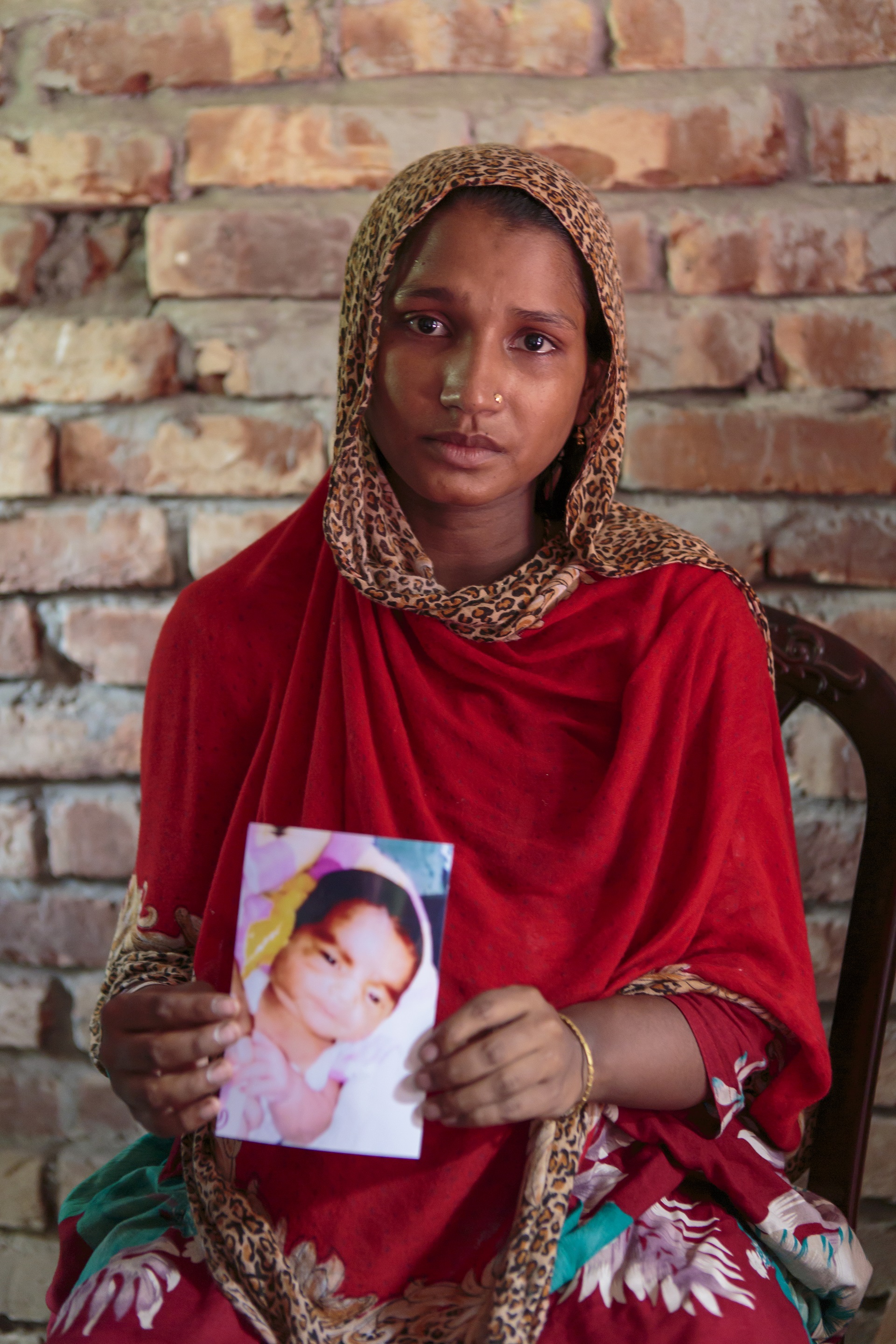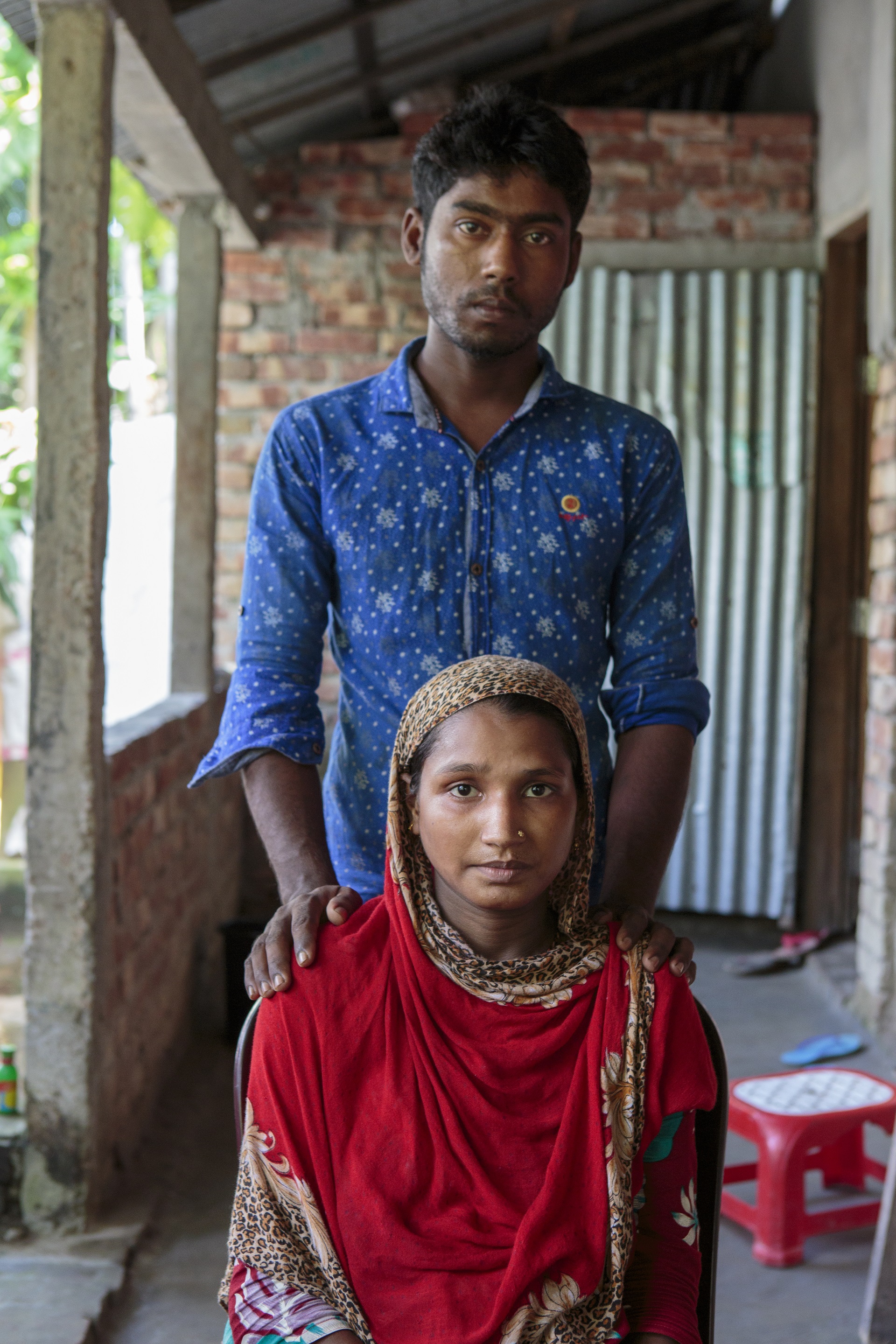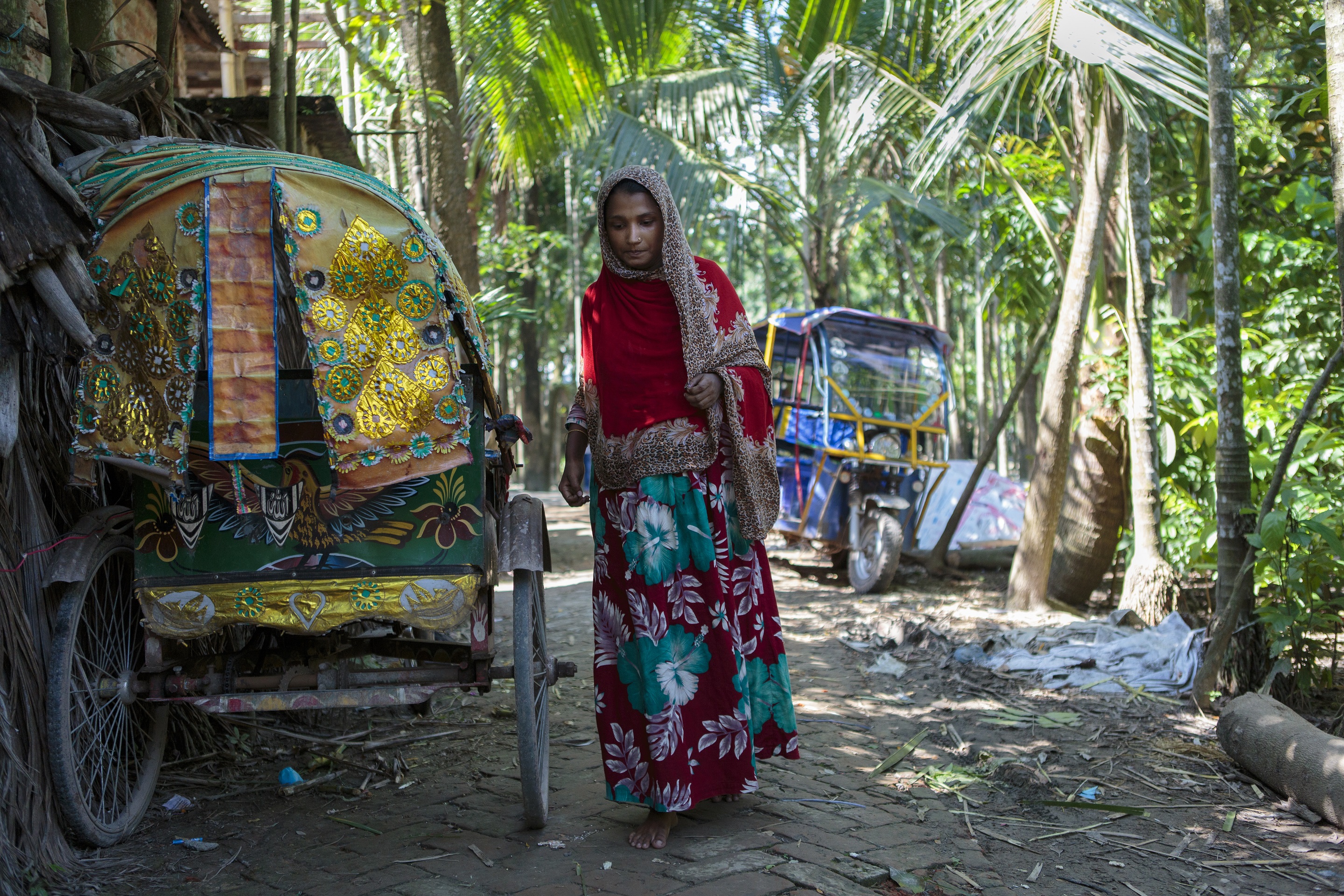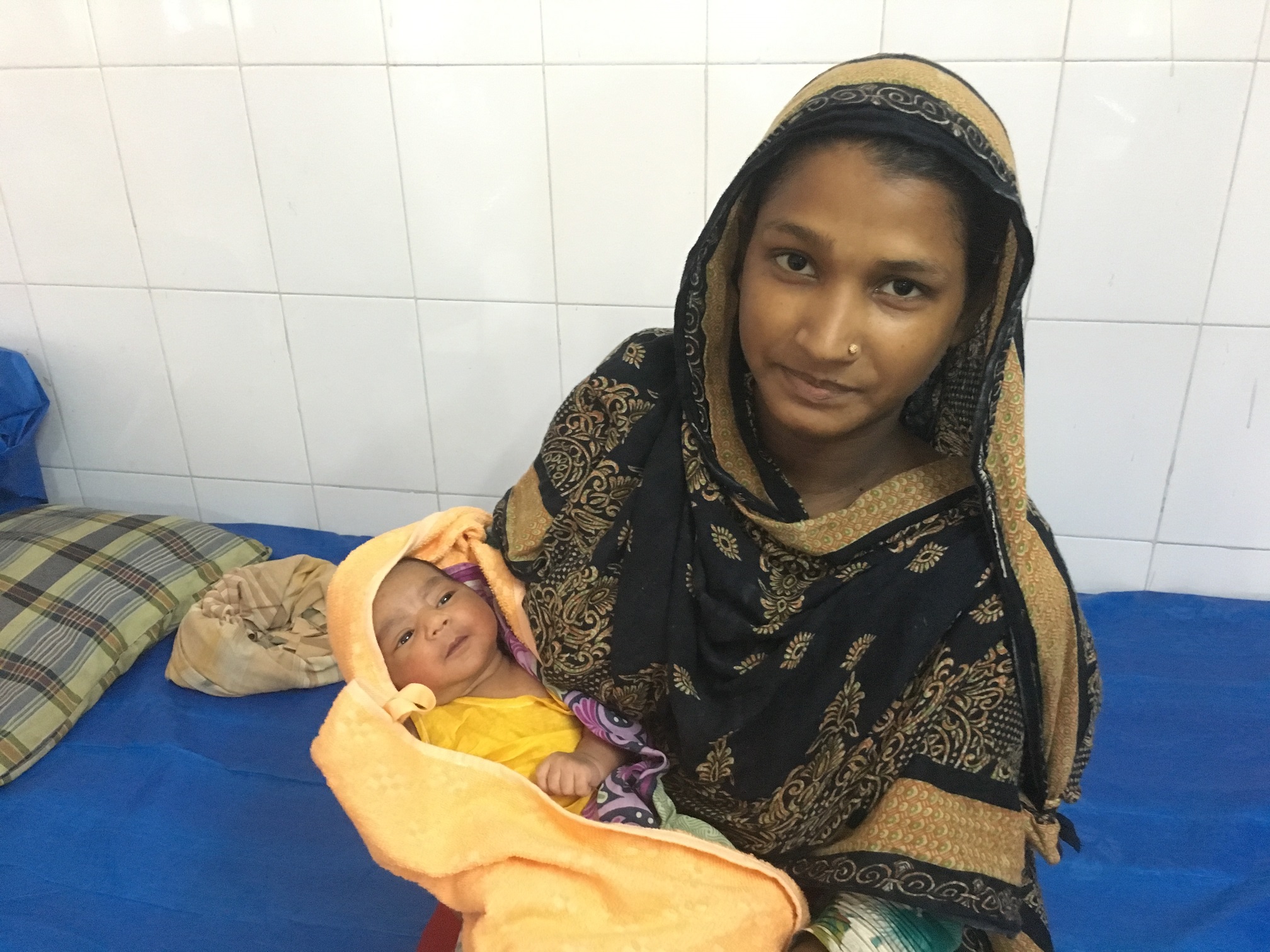Fardin
Fardin stares right at you. He looks intensely ready for the world. Dark hair frames his tiny face, and a blanket of pink, yellow and white cradles his new body. His pudgy hand reaches to a single delicate thumb. His mother’s. Jesmin.
Fardin came into the world on October 10, 2018. He was born at his grandparent’s house in Gazipur district, a semi-rural area just north of Dhaka. When he was born, the person helping Jesmin to deliver cut Fardin’s umbilical cord with
a shaving blade.

Jesmin Akter, now 18 years old, with a photo of her infant son Fardin. Fardin died of tetanus when he was just 11 days old. (Photo credit: WHO SEARO / C. McNab)
“He was very well, very normal,” says Jesmin.
Little Fardin died on October 21, 2018 – eleven days after his birth. He died suffering violent convulsions that thrust his body into a backward arch, a locked jaw he couldn’t open to feed, and fever. He succumbed to neonatal tetanus.
Jesmin clutches his photograph. It’s the only one she has. Then she looks away, and wipes the tears forming in the corners of her eyes.
This tragedy isn’t only Fardin’s death. It is that his death could have been prevented.
Fardin is the rare newborn to die of neonatal tetanus in Bangladesh. The disease was eliminated from the country in mothers and newborns in 2008.
Tetanus
Tetanus is an acute infectious disease caused by the spores of the bacterium Clostridium tetani. The bacterium lives in the everyday environment – in soil and ash, in rusted tools, nails or barbed wire, on human skin, in the intestinal tract, in
human feces and in manure. A person can be infected when the bacterium enters the body, normally through a cut in the skin. The disease can affect anyone but is particularly common and serious in newborn babies and in pregnant women who haven’t
been immunized with tetanus toxoid vaccine.
Bangladesh’s success in eliminating what is known as “MNT” – maternal and neonatal tetanus – is largely due to a country policy that recommends women of childbearing age be vaccinated at least five times with a tetanus-containing
vaccine between ages 15 and 49, and to the efforts of health workers who see that policy through in every community.
High Coverage
Down a leafy pathway in Boktarpur village, seven young women sit on a bench in a small community centre, listening to Razia Sultana, their health worker. She explains the role vaccines play to protect them and their future babies.
“What is tetanus?” Razia asks. One woman responds using her body, mimicking the rigour of the whole-body spasm typical of tetanus disease. The other women nod – they also knew the grim answer.

Razia Sultana, a health assistant, prepares a tetanus-containing vaccine. The young woman waiting is meant to receive five doses of tetanus-containing vaccine between the ages of 15 and 49. Each dose is given at a prescribed interval for full protection during a woman’s reproductive years. (Photo credit: WHO SEARO / C. McNab)
After the conversation, these women will be vaccinated against tetanus. For some it will be the second or third time as young women. They are on track to protecting themselves and their future newborns against the disease. They are like most Bangladeshi
women – WHO and UNICEF estimate that 98% of newborns are protected from tetanus at birth.
“I enjoy and love this work,” says Razia, who at 30, isn’t much older than some of the women present. “I’m protecting my community. I’m helping them.”

A teen girl holds her shoulder after receiving a tetanus vaccine at her local primary health care centre in Gazipur district, Bangladesh. (Photo credit: WHO SEARO / C. McNab)
The women trust Razia, but they don’t love the injection. The tetanus toxoid vaccine is given by intramuscular injection – meaning, the needle penetrates, for just a second or two, deep into the muscle. Afterwards, the spot may be tender
to the touch. A woman may feel nauseous, be tired or have joint pain for a few days. For some, that pain seems too much. A 2016 study for example, showed that about four in ten rural Bangladeshi women feared the tetanus toxoid vaccine.1
Jesmin’s story – from despair to new life

Jesmin and her husband, Samin Mohammed. (Photo credit: WHO SEARO / C. McNab)
Jesmin Akter is now 18. She was 17 when she married her husband, Samin Mohammed, who is now 22. He drives a rickshaw, and she stays at home.
Jesmin’s mother is also a housewife, and her father is paralysed and can’t work. Jesmin says she never received any vaccinations, even as a child. She has a grade six education. She says she loves to watch movies when she has free time, especially
Hindi movies.
Jesmin became pregnant shortly after she and Samin Mohammed were married.
She went for two antenatal visits, where a pregnant woman is typically weighed, blood pressure is taken, supplements such as iron and folic acid may be given, and tetanus toxoid vaccine would be recommended.
“I didn’t have any of the tetanus vaccinations,” she says. When asked why, she says she was afraid they would cause pain.
Her friends were vaccinated, she explains. But she was scared. And because antenatal visits indicated that the baby was healthy, she went for just two visits, and not the four recommended by health workers.
She felt unwell with the pregnancy – typical symptoms such as nausea and fatigue – and decided to travel back to her parents’ house in a different village where she remained for the pregnancy.
And it was at their house that little Fardin was born on October 10, 2018, healthy and well. There was no skilled birth attendant present, which is typical for about four in ten Bangladeshi women.2
Fardin was well until he was six days old. On the seventh day, Jesmin says he began to have a fever. His body convulsed and he couldn’t suckle. His condition worsened. And then began a nightmare of trying to get medical care.
Her family took him to a local hospital, but Jesmin says there was a strike, and no doctors were present. The family travelled to a children’s hospital, but there were no beds available.
They returned to the parent’s home, where Fardin only became sicker. They then went to a private hospital, which admitted Fardin in the intensive care unit for one day. On the way home from that hospital, little Fardin died.

Health worker Shaina Sultana sits with Jesmin Akter. Shaina is helping Jesmin to get through her second pregnancy in the healthiest way possible. (Photo credit: WHO SEARO / C. McNab)
Jesmin cries as she tells this story. The health worker sitting with her, Shaina Sultana, tears up as well.
Afterall, seeing the photograph of this tiny baby, hearing Jesmin’s desperate story, her sorrow, and knowing that simple vaccination would have prevented all of this - well you can’t help but cry.
It’s difficult to say if Fardin was infected with tetanus from the razor blade used to cut his umbilical cord, or through some other route. Without proper care, the umbilical cord is a dangerous route of infection of tetanus and other pathogens.
A study of 520 women in rural Bangladesh showed that 42% of births involved unclean cord care. 3 This can include use of unsterilized instruments to cut the cord, applying nonhygienic substances (such as mustard oil or ash) and hand
washing without soap. As an unskilled person brought Fardin into the world, any of these things could have happened.
But one thing is sure, if Jesmin had been protected with tetanus toxoid vaccine, Fardin wouldn’t have been infected. And while she went only twice for antenatal care, Jesmin’s health worker might have spent more time talking with Jesmin,
to convince her that tetanus vaccine was safe and essential to her newborn’s health.
The good news

Jesmin Akter became pregnant again. She received all necessary tetanus vaccinations, went for antenatal care and felt very well. (Photo credit: WHO SEARO / C. McNab)
Here’s the good news. Jesmin became pregnant again. When we met with her in late August she was eight months along and feeling good. She was staying with her husband’s family and had regular antenatal care.
She was up to date with her tetanus toxoid vaccinations. The health worker, Shaina Sultana, assured Jesmin she and the entire community health team would be with her every step of the way through delivery of her new baby.
“Jesmin is a priority to us,” explained Shaina. “We will stay with her so she and her baby remain healthy.”
And they did.

Jesmin and her new baby Sumi, at the hospital where Sumi was born. Mother and baby are doing very well. (Photo credit: Roy Prosun / WHOSEAR)
On October 21 at about 3 pm Jesmin gave birth to a baby girl at the Kaliganj Upazila Health Complex. There were complications at the last stage of her pregnancy – Jesmin’s waters broke early and the amniotic fluid became too low -
so doctors performed a caesarean.
And now, Jesmin and Samin have a healthy new daughter. She weighed 2.8 kilos at birth and has beautiful bright eyes.
Jesmin and Samin have named her Sumi.
Bangladesh’s Maternal Neonatal Tetanus Success
Jesmin’s story is atypical in Bangladesh. WHO and UNICEF estimate that the overwhelming number of newborns (98%) are considered protected at birth from tetanus.
The number of newborns dying of tetanus has declined 95%, from an estimated 29,000 in 1990, to 700 in 2015. 4 This is excellent progress, though behind every newborn death is the tragedy of potential unreached and tremendous loss
and pain for a family.
Bangladesh eliminated maternal and neonatal tetanus in 2008 – an important public health achievement. This means that in every district of Bangladesh, no more than one baby in 1,000 born suffers tetanus. The country continues to show impressive
results with high coverage of at least two doses of tetanus toxoid vaccine.
We must thank Jesmin for telling her story. She relived a terrible experience so that we can all be reminded to do better for mothers and their newborns in the future.
Expectant parents should attend antenatal care eight times, ideally, and this should be available within easy travel distance. Health workers need the tools – including the tetanus vaccines – but also the communication skills – to
ensure pregnant women and their newborns are protected from tetanus. Women should ideally deliver in well-equipped health centres that provide quality care; and at the very least, with a skilled birth attendant at home.
It’s up to a country’s health sector, and ultimately government and its development partners to ensure women like Jesmin can have safe deliveries every time, with newborns like Sumi, who thrive.
[1] Bangladesh EPI Coverage Survey Evaluation 2016. Expanded Programme on Immunization, Bangladesh Directorate General of Health Services. Page 169.
[2] Bangladesh Demographic and Health Survey 2014. Dhaka, Bangladesh: NIPORT, Mitra and Associates, and ICF International. Available at http://dhsprogram.com/pubs/pdf/FR311/FR311.http://dhsprogram.com/pubs/pdf/FR311/FR311.pdf.
[3] Islam MT, Islam N, Yoshimura Y, Nisha MK, Yasmin N. Newborn Care Practices in Rural Bangladesh; Research and Reports in Neonatology. 2 July 2015 Volume 2015:5 Pages 65—72. DOI https: https://doi.org/10.2147/RRN.S87122.org/10.2147/RRN.S87122
[4] Hmwe H. Hmwe H. KyuKyu, John Everett Mumford, Jeffrey D. Jeffrey D. Stanaway, Ryan M. Barber M. Barber, et al. Mortality from tetanus between 1990 and 2015: findings from the global burden of disease study 2015. BMC Public Health Public Health. 2017; 17: 179. Doi: 10.10.1186/s12889-017-4111-4







